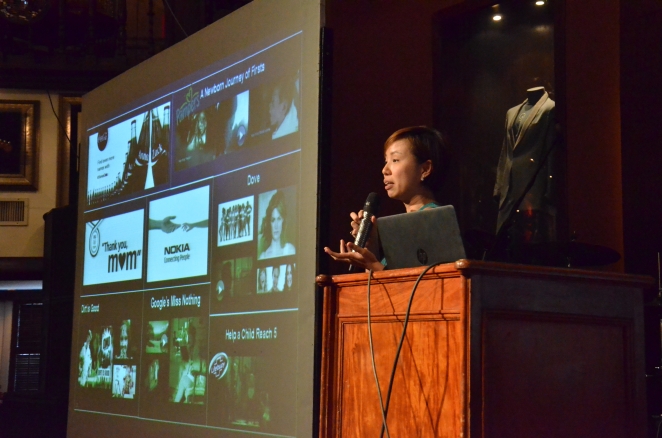
“Communications, stories that have touched you, tales from childhood, these are emotions, and they count because if we just focus on the product without attempting to make people feel, these brands wont be emotionally meaningful for most people.
People won’t care about the brand, and ads either,” explains Ng. She cites YouTube numbers where 70% of consumers skip pre-roll ads after the first 5 seconds, and Filipinos skip pre-roll ads after 7-12 seconds. “Emotion is the key to puncturing consumer apathy,” she says.
Originally from Singapore, Ng moved to Millward Brown Philippines in March, where she admits, she is blending seamlessly. Known in the unit as a knowledge accelerator, Ng’s purpose is to drive technical innovation excellence with key clients. And know clients and brands well, she does. Ng’s collection of case studies starts off with Nokia, and its product-oriented communications. Then the pioneer, top-of-mind mobile phone brand, has been reduced to rubble in the wake of lifestyle-led advertising from Apple, and Samsung.
Ng continues to debunk myths like: Decision-making is not solely emotional. She explains, “Rational benefits can lead to emotional rewards. We are reationalizers, not rationalizers, where the right choice feels good.” Illustrating a brand benefit in an emotional way, or connecting the emotional benefit to the brand reaps the best rewards, and the likelihood of the effect on sales.
There are time-honored, tricks of the trade on how to best generate emotions. Ads that talk about human stories generate the most emotions. Human stories that can actually strike back on the cynicism draws the audience, your consumer, into the story. The more immersed they are in the story, the better chances of their buy-in, and their loyalty down the road.
Ng advises brands to: 1. Start with a simple, powerful human insight; 2. Build affinity through deeper meaning; 3. Leave people feeling positive; 4. Build associations; and 5. Be consistent across touchpoints.
“Effective communications are rooted in simple, yet powerful human insights. This shifts the brand promise, and can be neutral across geographical borders,” says Ng. She cites AXE, Pampers and Coca-Cola as brands that have successfully maneuvered single-themed campaigns across global markets.
Ng next cites Jollibee’s family-focused TVC that builds affinity. Bringing tears to the eyes of many at the event, Ng says of the work, “This is no ordinary fastfood brand.”
Coca-Cola’s spread happiness campaign undoubtedly crossed borders successfully, and the reason is because it leaves people feeling good. “Coca-Cola is always talking about optimism and being positive, giving feelings that come in all shapes, and sizes. This was not a TVC, but Coke documented exactly how people felt. Even though you weren’t there, you can’t help but share in the feeling,” she adds.
For the next tip, it’s Volkswagen-Passat’s thinking out of the box that gets special mention. The TVC of the young boy in Darth Vader costume was a hit a few years back, but the good vibes linger. “Sometimes it involves breaking category norms. Volkswagen Passat’s YouTube upload got 8m views overnight,” she shares.
Last, brands must be consistent across touchpoints, and Ng shares how Singapore Airlines’ TVC leveled up communications from It’s a great way to fly to the creatively innovative No detail is too small as the key to harnessing emotions in communications. “You have to find insight across geographies. Once you have a neutral idea, you can go into new markets, and talk to new people,” she says.
“The idea must not be isolated on one format, not specific to a media channel. Positioning can be global, but the communications must be local,” Ng adds.
[nggallery id=501]



